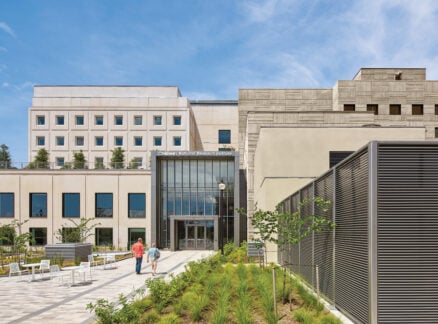
July 11, 2018
Bob Dylan’s Archives, No Longer a Rolling Stone, to Be Housed in Olson Kundig-Designed Center
The famed singer-songwriter’s vast archives will be housed in a brand new building within Tulsa’s industrial arts district.

Tulsa, Oklahoma is one step closer to becoming the epicenter for all things Bob Dylan.
After winning first place in an international design competition, Seattle-based firm Olson Kundig will be lead architect and exhibit designer for the Bob Dylan Center, which will house a collection of more than 100,000 items from the famed singer-songwriter’s archives. Tulsa-based Lilly Architects, in partnership with Olson Kundig, will be the architect of record, while Plains of Yonder is the collaborator for multimedia and audio experiences.
The Dylan collection, acquired by the George Kaiser Family Foundation and the University of Tulsa in 2016, is currently only open to researchers and academics by appointment. Set to be opened in 2021, the Center will be the public’s first chance to experience the Nobel Prize winner’s memorabilia, which includes notebooks, photographs, instruments, and unreleased studio and concert recordings, in person.
The Center largely owes its location to Tulsa billionaire George Kaiser’s efforts to revive the city, but it will also be located down the street from the Woody Guthrie Center. Guthrie is an idol of Dylan’s. “I’m glad that my archives, which have been collected all these years, have finally found a home and are to be included with the works of Woody Guthrie and especially alongside all the valuable artifacts from the Native American Nations,” said Dylan in a statement after the purchase of his archives. “To me, it makes a lot of sense and it’s a great honor.”

While the competition had participants submit designs remodeling an existing warehouse, the Center will be housed inside a brand new building within the Tulsa Arts District. The downtown neighborhood is populated with converted industrial buildings and historic manufacturing sites. “They are very efficient warehousing structures,” said firm principal Tom Kundig over email, “so we expect to pick up that same materiality to become integrated into this particular district of Tulsa.”
This locale will play an important role in the design process—Olson Kundig’s winning entry envisioned the Center’s activities spilling outside the building into the Arts District community through generous indoor/outdoor spaces, allowing “the interior life and activity of the exhibits and programs to be visible long before visitors cross the entry threshold,” according to Alan Maskin, Olson Kundig’s design principal of exhibits.
“Our idea with the competition entry was to basically strip back the building to its elemental parts and then explore how we would use those parts of the existing structure, such as existing walls, windows and roof,” added Kundig.
Although the firm is just beginning to study the archive and work alongside the archivists, preserving the items while exposing them to public viewing is “always the question when dealing with fragile archival materials,” said Kundig. “We are working on ways for the building itself to be protective of those archives, but also be transparent in very careful ways.”

The firm’s contest-winning renderings depicted the artifacts in a series of illuminated, floating vitrines. Throughout the galleries, the architects maintained the industrial spirit of the warehouse with a subdued palette of muscular exposed concrete and gray and black finishes. Within the listening area, the architects incorporated warmer materials and proposed a series of timberlined audio-equipped niches. A quote from Dylan’s book, Chronicles: Volume One, is inscribed on the ceiling.
Over the next few months, the firm will work to refine their initial design proposal and, if all goes to plan, the project will break ground next year. Ultimately, according to Kundig, the firm hopes the Center’s architecture will be like “the bassline in a piece of music.”
“The design should thematically support Bob’s legacy of continual change and reinvention,” the architect explained. “Our goal is to uphold that legacy with architecture and exhibits that are in a quiet, supportive role, rather than in a leading role.”
You might also like, “A Closer Look at David Adjaye’s First Skyscraper, Now Rising in Lower Manhattan.”










